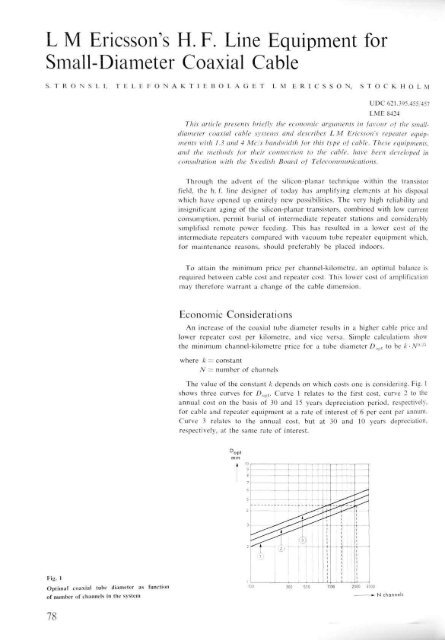1 - ericssonhistory.com
1 - ericssonhistory.com
1 - ericssonhistory.com
Create successful ePaper yourself
Turn your PDF publications into a flip-book with our unique Google optimized e-Paper software.
L M Ericsson's H. F. Line Equipment for<br />
Small-Diameter Coaxial Cable<br />
S. TRONSLI, TELEFONAKTIEBOLAGET LM ERICSSON, STOCKHOLM<br />
UDC 621.395.455/457<br />
LME 8424<br />
This article presents briefly the economic arguments in favour of the smalldiameter<br />
coaxial cable systems and describes LM Ericsson's repeater equipments<br />
with 1.3 and 4 Mc/s bandwidth for this type of cable. These equipments,<br />
and the methods for tlieir connection to the cable, have been developed in<br />
consultation with the Swedish Board of Tele<strong>com</strong>munications.<br />
Through the advent of the silicon-planar technique within the transistor<br />
field, the h. f. line designer of today has amplifying elements at his disposal<br />
which have opened up entirely new possibilities. The very high reliability and<br />
insignificant aging of the silicon-planar transistors, <strong>com</strong>bined with low current<br />
consumption, permit burial of intermediate repeater stations and considerably<br />
simplified remote power feeding. This has resulted in a lower cost of the<br />
intermediate repeaters <strong>com</strong>pared with vacuum tube repeater equipment which,<br />
for maintenance reasons, should preferably be placed indoors.<br />
To attain the minimum price per channel-kilometre, an optimal balance is<br />
required between cable cost and repeater cost. This lower cost of amplification<br />
may therefore warrant a change of the cable dimension.<br />
Economic Considerations<br />
An increase of the coaxial tube diameter results in a higher cable price and<br />
lower repeater cost per kilometre, and vice versa. Simple calculations show<br />
the minimum channel-kilometre price for a tube diameter D„ llt to be k • N"- 2T '<br />
where k = constant<br />
N = number of channels<br />
The value of the constant k depends on which costs one is considering. Fig. 1<br />
shows three curves for £> opt . Curve 1 relates to the first cost, curve 2 to the<br />
annual cost on the basis of 30 and 15 years depreciation period, respectively,<br />
for cable and repeater equipment at a rate of interest of 6 per cent per annum.<br />
Curve 3 relates to the annual cost, but at 30 and 10 years depreciation,<br />
respectively, at the same rate of interest.<br />
"opt<br />
mm<br />
;<br />
i<br />
M><br />
^^^\^^\^<br />
V VI) © 1<br />
| ^!_<br />
Fig. 1<br />
Optimal coaxial tube diameter as function<br />
of number of channels in the system<br />
1 i ' '<br />
i<br />
ii..<br />
N channels<br />
78
















